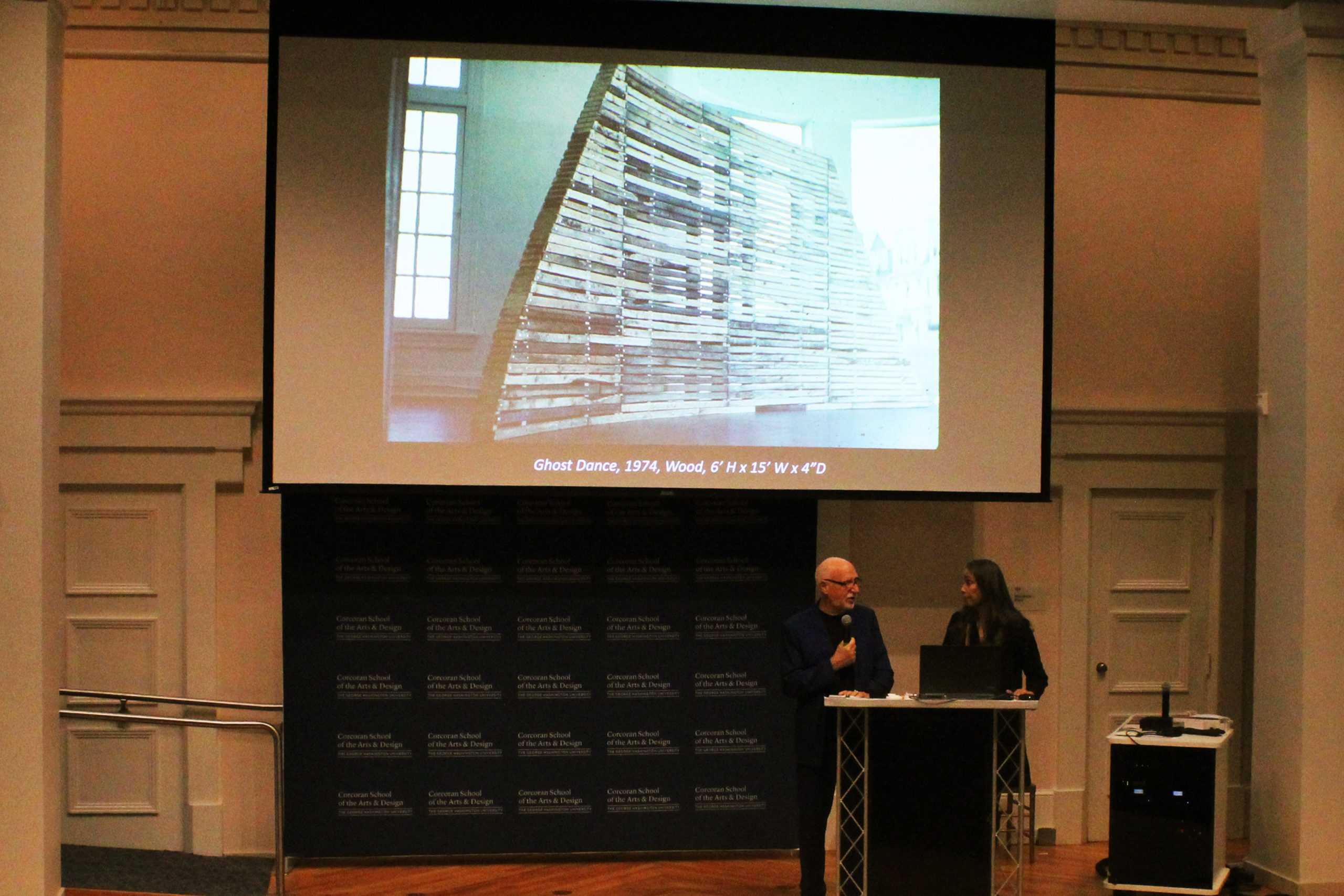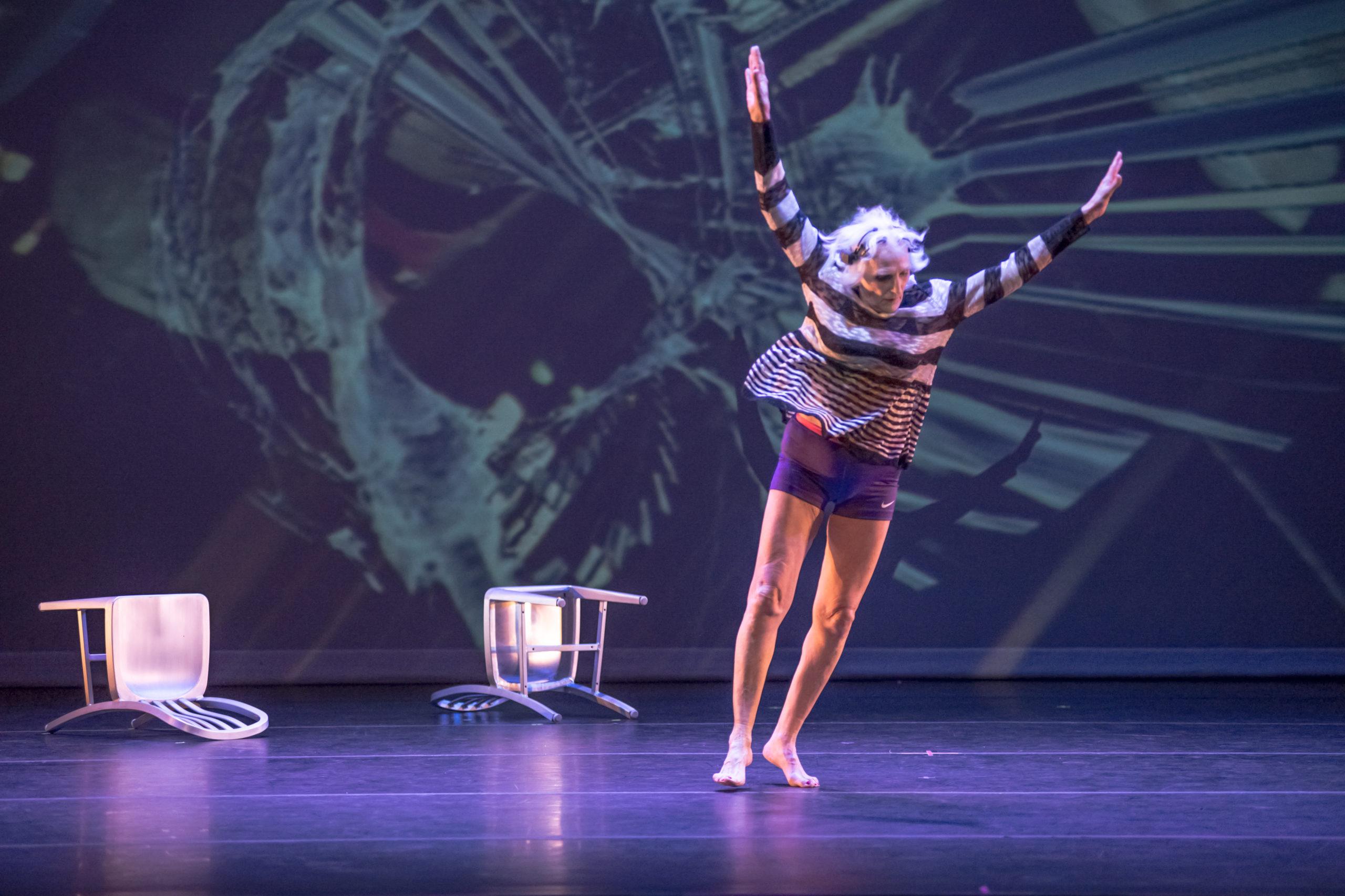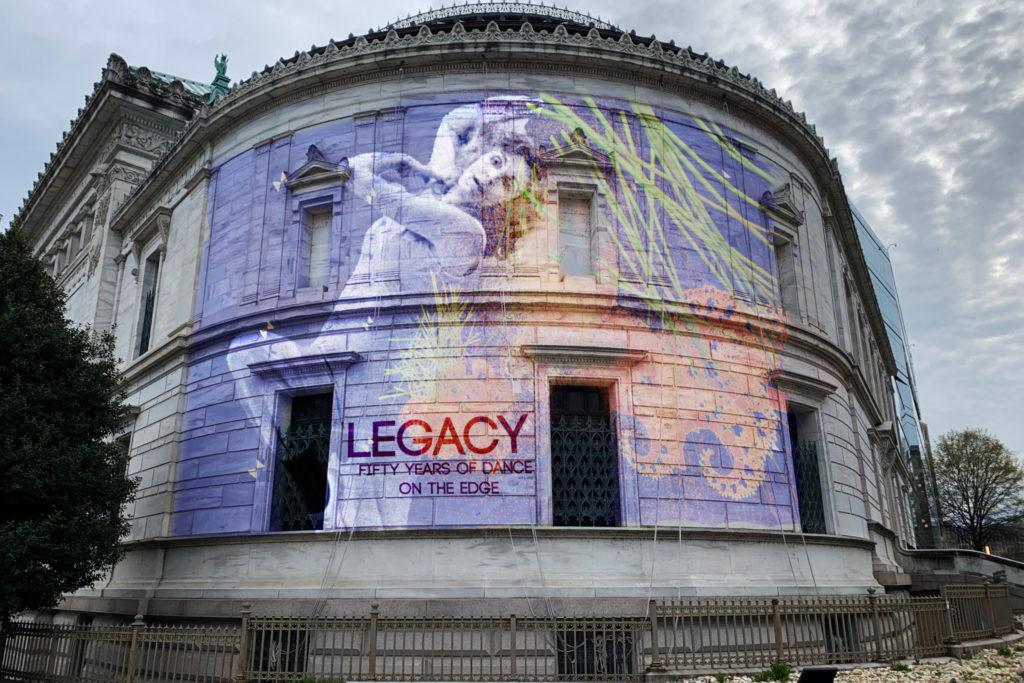Updated: Sept. 19, 2021 at 8:38 p.m.
The bronze doors of the galleries at the Corcoran School of the Arts and Design’s Flagg Building have opened for the gallery’s fall season, flooding the palatial atrium with sunlight and ushering in the return of large-scale, immersive exhibitions.
This month, the Luther W. Brady Art Gallery will debut a sculptural exhibition titled “Renewal” that highlights restored work by visual artist and sculptor Robert Stackhouse and “Legacy: Fifty Years of Dance on the Edge,” a celebration of the career of Corcoran dance professor Maida Withers. These two exhibits are respectively composed of sculptural art and video projections of dance choreography, marking the first of the fall season’s events.
Renewal
Ghost Dance – a nearly five-foot-tall, semicircular, vertical structure made of consecutive slats of recycled, industrial-grade wood – marks the focal point of Renewal. On the adjacent wall, a display of Stackhouse’s watercolor renderings of the sculpture and detailed instructions for its original construction in 1974 accompany the structure. Stackhouse first unveiled Ghost Dance nearly 40 years ago, drawing inspiration from the 19th-century Native American movement among the Nevada Northern Paiute to restore ownership of their land and way of life.

Krishna Rajpara | Assistant Photo Editor
Stackhouse and his wife, Carol Mickett, who are artistic collaborators, unveiled the opening of their exhibit with a reception and a lecture last week titled “Where we’ve been, where we are, where we’re going.” Babette Pendleton, Corcoran’s exhibition and programming associate, said the slogan encapsulates the exhibition, which centers around the restoration of the work of art.
The sculpture explores themes of renewal, rebirth and sustainability through its use of recycled materials and now through its rebirth as part of a new exhibition. The spiritual movement of Ghost Dance emerged after European settlers brought a period of devastating disease to the Paiute people in Nevada who wished to cleanse their land of the European settlers and sustain its natural beauty.
Pendleton said after sitting in the gallery’s storage for over a decade, Ghost Dance was in need of restoration. Visible disrepair on the wood and metal screws left Stackhouse and Mickett to decide between modernizing the construction or maintaining its original appearance, Stackhouse said.
“The sculpture was built not as a fine piece of furniture,” Stackhouse said. “It was built more like a sketch. So there’s no perfection in it. Not everything fits. Not everything is the same size. So the question was, to what extent do we change it?”
When viewers enter the gallery, Stackhouse invites them to circle the structure to experience the “ritualistic movement” of the architectural piece as light filters through the gaps in the wooden slats. He said the curvature of the piece gives it the shape of an arc when viewed from the side, but simply a horizontal line when viewed head-on.
When selecting pieces to accompany Ghost Dance in the Renewal exhibition, Pendleton said she worked alongside GW Collection curator Olivia Kohler-Maga, of the Brady Art Gallery, to put out an open call to the Washington Sculptors Group – a non-profit that supports sculpture artists in the District – to find work that would augment Stackhouse’s design and complement the exhibition’s space in the gallery. The result displays a vibrant assortment of sculptural art constructed from driftwood, an old shirt, shells, cardboard, leftover house paint and repurposed frames that invite the viewer to find the innate artistic nature in common recycled goods.
“Some are very obvious and some are very subtle,” Stackhouse said. “Some, I look at them and I don’t know what the intention of the artist was, but I can see some things where it’s a very clever use of the connection between what they see and what they did. So really, I’m happy to see that this sculpture helps people deal with their creative process.”
Open Wednesday through Saturday from 1 to 5 p.m. through Dec. 3.
Legacy: Fifty Years of Dance on the Edge
Friday will mark the opening of Legacy: Fifty Years of Dance on the Edge, a dynamic exhibition honoring Corcoran dance professor Withers’ spectacular body of choreographic work through technology, like projected video archives.
The daunting task of distilling a five-decade career of contributions to the dance world, with Corcoran included, into one exhibit was no small feat for Withers and her collaborators. The result is a cohesive production that displays her longtime love for dance and her leadership of the Maida Withers Dance Construction Company, a D.C.-based group that performs original choreography in the U.S. and around the world.

Photo Courtesy of Shaun Schroth
Withers has taught classes in topics like choreography, improvisation and performance art theory and practice at GW since 1965. She said she worked to expand the program so that it might include space for more dancers who didn’t fit the classic body types and dance styles expected in the classical ballet world to pursue undergraduate and master’s degrees in dance.
“When I came to the program, I brought the philosophy that dance should be for anyone who wants to do it,” Withers said.
Fifty years later, she has accumulated an archive of work that encompasses more than 100 pieces of original choreography memorialized in picture or video and aggregated in an online archive. Now in Legacy, she has selected seven pieces to be displayed in their full length on seven large monitors erected in the atrium of the gallery. In a room adjacent to the atrium, countless more choreographic works have been condensed into short, 10-second segments that will be projected in a mosaic of alternating videos spanning the entirety of the walls and ceiling, fully immersing the viewer.
To execute the projections, Withers said she collaborated with local projectionist Robin Bell who is known for projecting political statements onto influential buildings in the District, like the display of “Pay Trump bribes here” upon the Trump International Hotel during the four years of Donald Trump’s presidency. She said they worked together in complementary styles and share a proclivity for experimenting with light and lasers and incorporating pointed messages about censorship, intersectionality and the environment.
Withers said she is excited to see the gallery include an exhibition of dance because she doesn’t see dance featured in many museums.
“It’s rather symbolic for me, being able to have the University recognize that as a professor in the arts, there’s a lot of different places for a dance career at GW,” Withers said.
The opening event Friday will include a panel discussion titled “Dance in DC – 50 years….What happened?” in which a variety of D.C. dance experts will speak about their own experiences in the last 50 years of the dance world. A celebration on Oct. 7 at the gallery will include live performances by a number of musicians and dancers who have collaborated with Withers in the past.
Open Wednesday through Saturday from 1 to 5 p.m. History exhibition – open from Sept. 23 to Oct. 23. Projection installation – open from Sept. 23 to Dec. 10.
Erika Filter contributed reporting.
This post has been updated to correct the following:
The Hatchet misspelled Pendleton’s last name. The correct spelling is now reflected. We regret this error.








